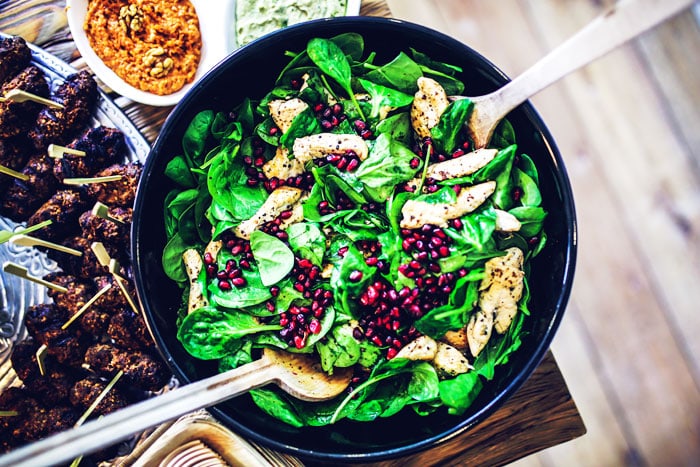
Written By: Gloria Tsang, RD
Title: Founding Registered Dietitian
Alumni: University of British Columbia
Last Updated on:

The Super Foods section of our website is very popular with our readers. It lists many healthy foods which are beneficial to health. Among all the foods listed there, I have decided to pick the top five healthiest foods for this article.

Table of Contents
Hands down! Salmon is my favorite food to substitute meats. It is a good source of protein and omega 3 fatty acids – which has been shown to decrease LDL cholesterol and raise HDL cholesterol. In 2002, the American Heart Association recommended eating at least 2 servings of fish a week, particularly fatty fish such as salmon. With increasing public concerns over farmed salmon, choose wild salmon. Most canned salmon are wild.
Soy products are great substitutes for animal products. I love cooking tofu with various tasty Asian sauces and also enjoy drinking soy milk. Soy beans contain high amounts of protein which comprise of all essential amino acids (the only such vegetable source to do so). Soy beans are also a rich source of calcium, iron, zinc, phosphorus, magnesium, B vitamins, omega 3 fatty acids and fiber. Numerous scientific studies demonstrated that a diet containing significant soy protein may benefit heart health. In addition, more and more studies are being published suggesting other health benefits of soy such as the prevention of prostate & breast cancer as well as osteoporosis.
For more details, read Benefits of Soy
Green vegetables such as kale, chard, collard greens, bok choy, broccoli, asparagus, green beans, etc… are packed with vitamins A and C, iron, calcium and phytonutrients. They are very filling, high in fiber and low in calories. Personally, I like eating them cooked so I usually stir fry them in a non-stick pan, but it is absolutely fine to eat them raw as well so go ahead and toss them into your salad and reap the nutritional benefits!
Berries by far are my favorite fruits! They are loaded with Vitamin C, folate, fiber and phytonutrients. Indeed, fresh berries are some of the most powerful disease-fighting foods available as they top the ORAC score chart (a method of measuring antioxidant activity). Berries are easy to prepare – just wash and rinse – no need to peel at all! In addition, you may serve berries (fresh or baked) as part of a dessert dish.
For more details, read Berries: Big Health Benefits in a Tiny Package
Whole grains have some valuable antioxidants not found in fruits and vegetables. They also contain B vitamins, vitamin E, magnesium, iron and fiber. The new 2005 Dietary Guidelines for Americans recommend that all adults eat half their grains as whole grains – that’s 3 to 5 servings of whole grains a day. To include more servings of whole grains in your diet, use whole-wheat flour in your recipes instead of white flour. Look for the word “whole” when purchasing packaged foods such as cereals, biscuits, pasta and breads. In addition, try adding wild rice, brown rice, quinoa or barley in your soup to increase whole grain intake.
Alumni: University of British Columbia – Gloria Tsang is the author of 6 books and the founder of HealthCastle.com, the largest online nutrition network run by registered dietitians. Her work has appeared in major national publications, and she is a regularly featured nutrition expert for media outlets across the country. The Huffington Post named her one of its Top 20 Nutrition Experts on Twitter. Gloria’s articles have appeared on various media such as Reuters, NBC & ABC affiliates, The Chicago Sun-Times, Reader’s Digest Canada, iVillage and USA Today.
cholesterol, heart smart, salmon, soy, whole grains